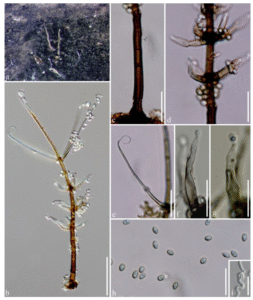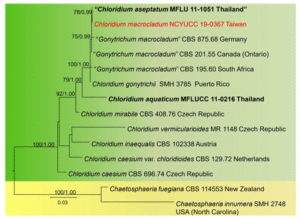Chloridium macrocladum (Sacc.) Karun., Maharachch., C.H. Kuo & K.D. Hyde, comb. nov.
≡ Gonytrichum macrocladum (Sacc.) S. Hughes, Trans. Br. Mycol. Soc. 34(4): 565 (1952) [1951]
≡ Chloridium aseptatum M.J. Wei & H. Zhang, in Wei, Zhang, Dong, Boonmee & Zhang, Phytotaxa 362(2): 191 (2018)
Index Fungorum number: IF 557649; MycoBank number: MB 557649; Facesoffungi number: FoF 06257; Fig. 50
Saprobic on culms of Pennisetum purpureum. Asexual morph: Conidiophores crowded, solitary with single erect main stalk, 275–290 × 5.5–7.5 μm (x̅ = 282.5 × 6.5 μm, n = 10), septate, dark brown becoming light brown towards the apex, swollen at the base and paler towards the apex; 3–4 collar-like hyphae appear underneath each node at the lower half of the conidiophore giving rise to an irregularly curved, succession of 2–4 phialides. Conidiogenous cells phialidic, cylindrical to lageniform, producing conidia from multi-conidiogenous loci, phialides borne around the conidiophore. Conidia 3.6–4.3 × 1.8–2.8 μm (x̅ = 3.9 × 2.3 μm, n = 40), ellipsoid to oval, subhyaline to olivaceous to light green, slightly flattened at the end. Sexual morph: unknown.
Material examined: TAIWAN, Chia Yi Province, Kwang Hwa, 18 March 2018, Anuruddha Karunarathna AKTW 58 (MFU 19-1003), living culture, NCYUCC 19-0367.
GenBank numbers: ITS: MK963072; LSU: MK963073.
Notes: Gonytrichum is a synonym of Melanopsammella and later was synonymized with Chloridium, which Hyde et al. (2020a, b) followed. In our phylogenetic analysis (Fig. 51), the strains NCYUCC 19-0367 and CBS 875.68 show 0.98 similarity in the ITS region. Hence, we introduce C. macrocladum NCYUCC 19-0367, a new host and geographical record. The strain NCYUCC 19-0367 is 99.8% identical to C. aseptatum MFLU11-1051 (514/515 bp similarity). The solitary disagreement is due to a gap in C. aseptatum MFLU11-1051 occurring above the adenine–thymine in the NCYUCC 19-0367 sequence at the 503rd position. According to the morphology along with similarities in the ITS sequence data, we propose C. aseptatum as a synonym of C. macrocladum.

Fig. 50 Chloridium macrocladum on decaying stem of Pennisetum purpureum culms. a Conidiophores on host. b Conidiophore. c Base of the conidiophore. d Conidiogenus cells on conidiophore. e Coiled terminal setae. f, g Conidiogenesis. h Conidia. i Conidia germination. Scale bars: b–d = 50 µm, e–i = 10 µm

Fig. 51 Maximum likelihood tree based on a combined dataset of LSU and ITS partial sequences. Bootstrap support values for maximum likelihood (ML) ≥ 75% and Bayesian posterior probabilities (PP) ≥ 0.98 are displayed above the nodes respectively. The tree is rooted with Chaetosphaeria fuegiana CBS 114553 and C. innumera SMH 2748. Newly generated sequence is indicated in red. The ex-type isolates are in bold
